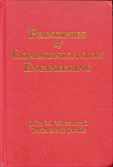“This classic text in communication theory retains its value completely today. I prefer it to many newer books.” — L. B. Levitin, Boston University
“I’m glad it is still available. It is very readable and covers the basic ideas with reasonable notation.” — Filson Glanz, University of New Hampshire
“This is my favorite communications textbook. Despite its age, the material covered in the book is very much relevant to modern communications systems.” — Venugopal Veeravalli, Cornell University
“An indispensable classic treatment of the basic concepts of communication engineering; a must for serious researchers in the field.” — Ernest L. Walker, West Virginia University
“I like the text’s systematic treatment of the concept of signal space, which I find most students struggle to grasp.” — Jing Jiang, North Carolina A&T State University
“In my opinion, nobody has written a text that reflects the development of an emerging technology the way Wozencraft and Jacobs did for communications/telecommunication technology.” — Behnam Kamali, Mercer University
“The rigorous treatment of optimum signaling schemes is superb and should be required reading for advanced graduate students working in communication theory.” — Vijaya Kuman, Carnegie Mellon University
“Your company was wise to reprint this great book. The price is very reasonable and the quality of print is excellent.” — Mohsen Kavehrad, Penn State University
“Students like the textbook because it is easy to read and focuses on fundamentals without the usual clutter.” — Costas N. Georghiades, Texas A&M University
“One cannot help to be impressed by the accomplishments of these authors. It is hard to overestimate the importance of this book. It is one of the basic books used by every communication engineer involved in research and design.” — George Zrilic, New Mexico Highlands University
“I like the book best because it describes the key points immediately and focuses on the most important concepts. Students learn quickly and solidly.” — Henry Yeh, California State University, Long Beach

720 pages, $97.95 list
0-88133-554-1
978-0-88133-554-5
© 1965
paperback
Solutions Manual available
Principles of Communication Engineering
The content and scope of this highly regarded book--the first overall synthesis of its kind--is reflected in three important objectives: (1) to establish a sound frame of reference for further study in communication, random processes, and information and detection theory; (2) to make the central results and concepts of statistical communication theory accessible and intuitively meaningful to the practicing engineer; and (3) to illuminate the engineering significance and application of the theory and to provide a quantitative basis for the compromises of engineering design.
Reactions
1. Introduction
Historical Sketch / Plan of the Book / The Role of Communication Theory
2. Probability Theory
Randomness in the Real World / Mathematical Model of Probability Theory / Random Variables / Expected Value / Limit Theorems
3. Random Waveforms
Random Processes / Filtered Impulse Noise / The Multivariate Central Limit Theorem / The Gaussian Process / Correlation Functions and Power Spectra
4. Optimum Receiver Principles
Basic Approach to Optimum Receiver Design / Vector Channels / Waveform Channels / Receiver Implementation / Probability of Error
5. Efficient Signaling for Message Sequences
Sequential Sources / Bit-by-Bit and Block-Orthogonal Signaling / Time, Bandwidth, and Dimensionality / Efficient Signal Selection / Channel Capacity / Reliability Functions
6. Implementation of Coded Systems
Transmitter Implementation / Receiver Quantization / Binary Convolutional Codes / Sequential Decoding / Summary of Results
7. Important Channel Models
Effects of Filtering / Bandpass Channels / Random Amplitude and Phase / Fading Channels / Coding for Fading Channels
8. Waveform Communication
Linear Modulation / Twisted Modulation / Frequency Modulation / Channel Capacity / Pulse-Code Modulation
Historical Sketch / Plan of the Book / The Role of Communication Theory
2. Probability Theory
Randomness in the Real World / Mathematical Model of Probability Theory / Random Variables / Expected Value / Limit Theorems
3. Random Waveforms
Random Processes / Filtered Impulse Noise / The Multivariate Central Limit Theorem / The Gaussian Process / Correlation Functions and Power Spectra
4. Optimum Receiver Principles
Basic Approach to Optimum Receiver Design / Vector Channels / Waveform Channels / Receiver Implementation / Probability of Error
5. Efficient Signaling for Message Sequences
Sequential Sources / Bit-by-Bit and Block-Orthogonal Signaling / Time, Bandwidth, and Dimensionality / Efficient Signal Selection / Channel Capacity / Reliability Functions
6. Implementation of Coded Systems
Transmitter Implementation / Receiver Quantization / Binary Convolutional Codes / Sequential Decoding / Summary of Results
7. Important Channel Models
Effects of Filtering / Bandpass Channels / Random Amplitude and Phase / Fading Channels / Coding for Fading Channels
8. Waveform Communication
Linear Modulation / Twisted Modulation / Frequency Modulation / Channel Capacity / Pulse-Code Modulation